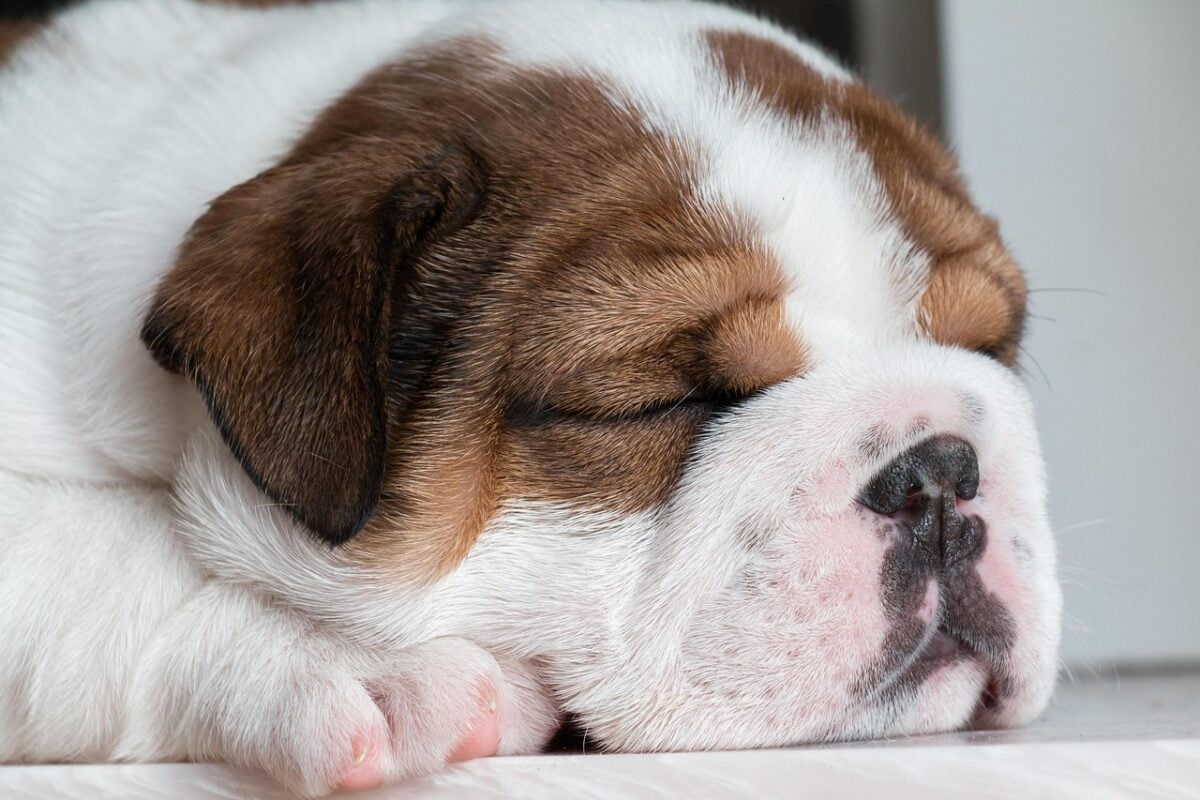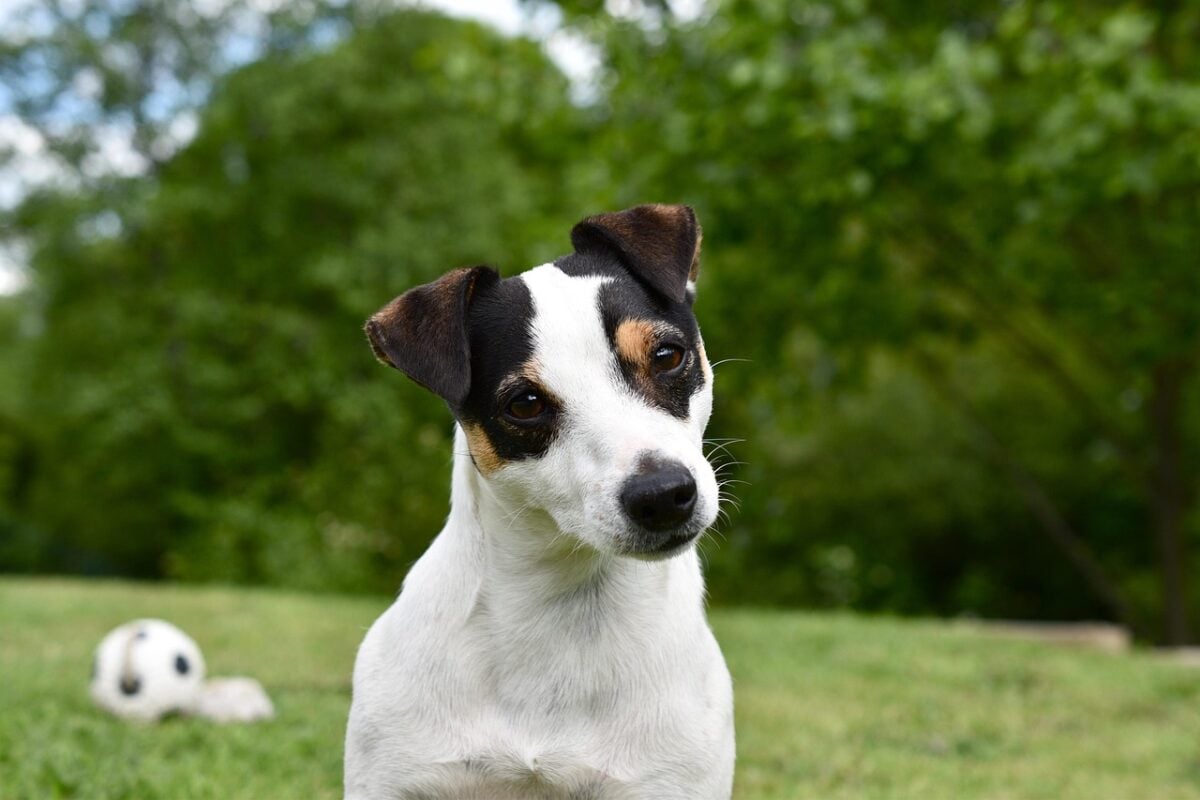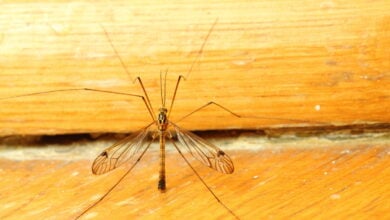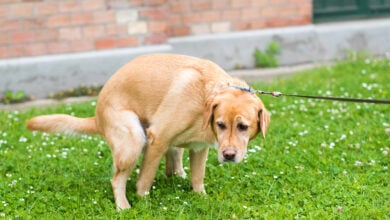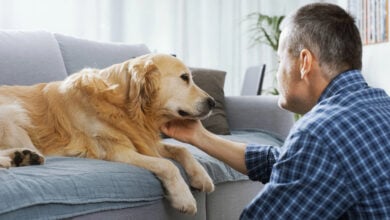Loud Snoring, Gasping, Or Weird Sleep Positions? It Might Be Dog Sleep Apnea
When you purchase through links on our site, we may earn a commission. Here’s how it works.
You’re drifting off to sleep when your dog’s snoring jolts you awake. It’s more than a gentle rumble — sometimes they gasp, snort, or even stop breathing for a few seconds. It’s easy to laugh it off, but those noisy nights could signal something more serious: canine sleep apnea.
Table of Contents
Just like humans, dogs can experience interrupted breathing during sleep, and it can affect their energy, health, and even heart function over time. Some breeds are more prone than others, and spotting the signs early can make all the difference.
In this guide, I’ll break down what sleep apnea looks like in dogs, why it happens, and how vets can help your pup sleep (and breathe) soundly again.
What Is Sleep Apnea?
Obstructive sleep apnea (OSA) is a disorder that causes repeated pauses in breathing during sleep. These pauses, known as apneas, can last 10–20 seconds or longer and disrupt the normal sleep cycle, especially during REM (rapid eye movement) sleep, when muscles naturally relax.
Can Dogs Have Sleep Apnea?
OSA isn’t just a human problem; dogs can develop it, too. In both species, it’s caused by something blocking the upper airway during sleep, making breathing shallow or stopping it altogether for several seconds at a time.
During REM sleep, a dog’s throat and tongue muscles naturally relax. If their airway is already narrow — from allergies, excess weight, or anatomy — those relaxed muscles can collapse inward and cut off airflow.
That’s why you might notice your dog snoring, gasping, or momentarily stopping breathing while asleep. Some pups even jerk awake as their body reacts to the lack of oxygen.
Quick Fact: Because dogs can’t describe fatigue or morning grogginess, the first signs of sleep apnea are usually seen by observant owners who notice pauses in breathing, gasping, or restless nights.
Why Some Dogs Struggle To Breathe In Their Sleep
Sleep apnea is not a disease by itself but a symptom of an underlying problem that restricts airflow. The most common culprits involve:
1. Flat-Faced Breeds & BOAS: When Cute Noses Cause Big Problems
Dogs with short, flat faces, such as English Bulldogs, Pugs, French Bulldogs, Boston Terriers, and others, are genetically predisposed to airway obstruction. This cluster of anatomical issues is known as brachycephalic obstructive airway syndrome (BOAS).
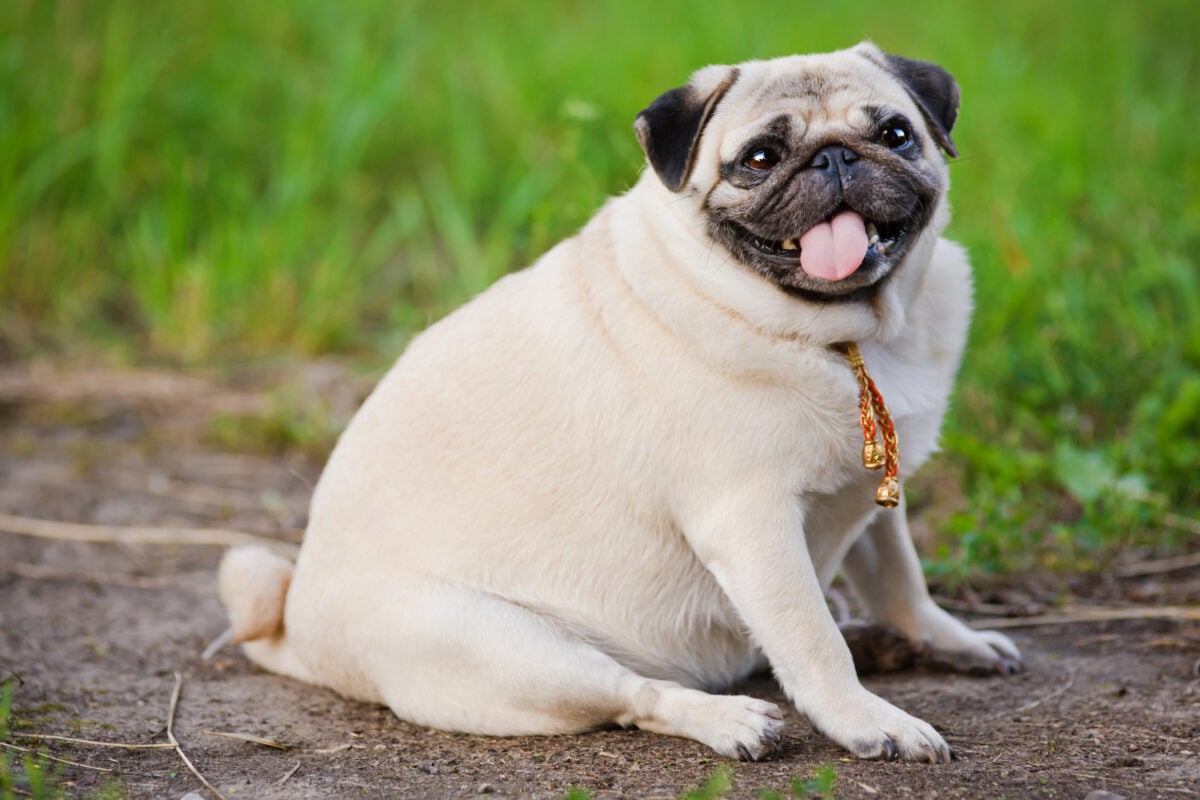
Anatomical features can include:
- Stenotic nares: Narrow or underdeveloped nostrils that restrict the amount of air entering the nasal passages.
- An elongated soft palate: The soft palate at the back of the roof of the mouth is too long and hangs down, partially or fully blocking the airway.
- Hypoplastic trachea: The windpipe is narrower than normal, making it harder for air to pass through to the lungs.
- Everted laryngeal saccules: The tissue inside the larynx (voice box) gets pulled outward and into the airway due to increased breathing effort.
- Other potential features: Some dogs may also have enlarged tonsils or an enlarged tongue that takes up more space than normal in the oral cavity.
These structures make breathing more difficult, especially during sleep when throat muscles relax. Even mild snoring in a brachycephalic dog can be an early warning sign.
See 19 brachycephalic breeds that are affected by some form of BOAS. This disorder can range from mild to severe.
2. Allergies That Clog Up Your Pup’s Airway
Allergic reactions, whether from pollen, dust mites, smoke, or food, can cause nasal inflammation and airway swelling, which narrow your dog’s breathing passages. Dogs with chronic allergies often snore, snort, or have labored breathing even while awake.

If nighttime breathing problems worsen during allergy season, your vet may explore treatment options like antihistamines or environmental changes.
Consider An At-Home Dog Allergy Test
Some owners try at-home dog allergy tests that analyze saliva or hair samples to detect potential food and environmental sensitivities.
3. Extra Pounds, Extra Pressure: Obesity’s Role In Sleep Apnea
Extra body fat, especially around the neck and chest, can compress the airway and make it harder for a dog to breathe deeply while sleeping. Obesity also increases the risk of heart and respiratory issues, which can compound sleep apnea symptoms.

Maintaining a healthy weight through a balanced diet and regular exercise is one of the simplest ways to reduce your dog’s risk. If your pup is overweight, consult your vet for a proper weight loss plan.
Did You Know? Just a 20% drop in body weight can significantly improve airflow and ease breathing in overweight dogs.
4. Getting Older Can Make Breathing Harder, Too
As dogs get older, muscle tone naturally decreases, including in the throat and soft palate. This relaxation can make the airway more collapsible during deep sleep.
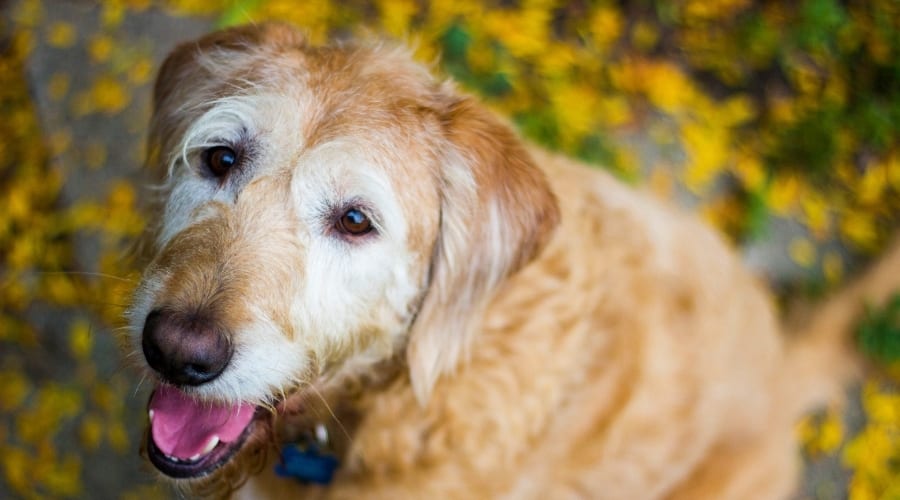
Senior dogs are also more likely to have underlying heart, lung, or neurological issues that may worsen breathing interruptions. Regular vet checkups help identify early signs before they progress to sleep apnea.
Is My Dog’s Breed More Likely To Get Sleep Apnea?
Some dogs are simply built to struggle a little more with breathing, especially those with short, flat faces. Their charming squished noses often come with narrow airways, elongated soft palates, and small nostrils, which make breathing harder during sleep.
Breeds At Higher Risk
- Bulldogs (English & French) – thick soft palate and narrow nasal openings
- Pugs & Boston Terriers – compact airways easily collapse during REM sleep
- Boxers & Shih Tzus – broad skulls with shortened snouts
- Overweight or senior dogs – extra tissue or weaker throat muscles can block airflow even in long-nosed breeds
Vet Insight: You don’t need a flat-faced pup to see sleep apnea. Any dog who gains weight, snores loudly, or gasps during rest deserves a vet checkup.
Sleep Apnea Symptoms You Shouldn’t Ignore
A dog with sleep apnea may visibly struggle to breathe while sleeping, often startling owners who wake to the sound of gasps, snorts, or silence between breaths.
The hallmark sign is the presence of apneas (breathing pauses) or hypopneas (very shallow breaths) that last 15–20 seconds or longer. These episodes can happen several times a night and often go unnoticed unless you’re watching closely.
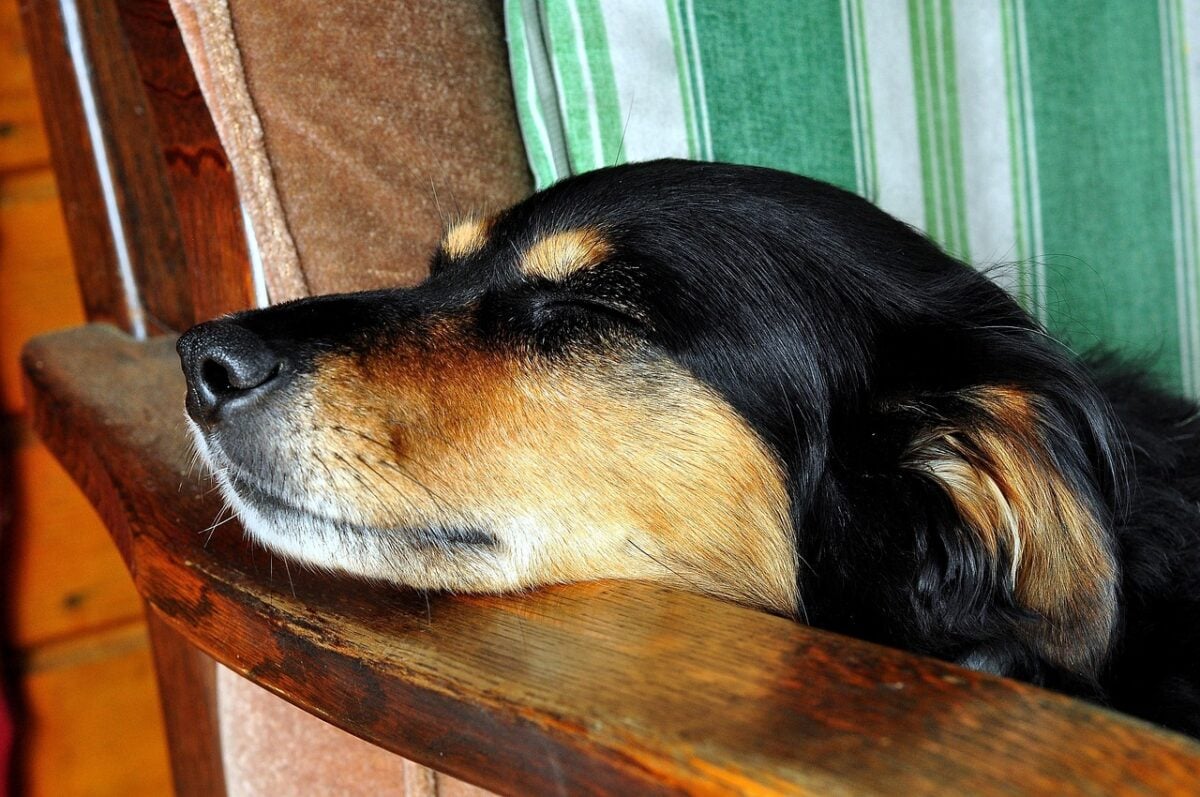
What It Looks Like While They’re Sleeping
- Noisy or labored breathing during sleep
- Gasping, choking, or snorting
- Pauses in breathing (sometimes followed by abrupt inhalation)
- Loud snoring, especially in short-nosed breeds
- Frequent waking or restless movement at night
- Sleeping in an upright or unusual position to open the airway
- Mouth breathing or drooling during rest
- Daytime fatigue or lethargy
- Mood or behavior changes from poor sleep quality
Vet Tip: Sleep apnea symptoms tend to worsen during REM sleep, when muscles are most relaxed. If your dog’s breathing sounds fine during naps but worsens in deep sleep, that’s a clue worth noting for your vet.
Is Sleep Apnea In Dogs Dangerous?
Yes. Untreated sleep apnea can become dangerous over time. Each pause in breathing reduces oxygen flow to the brain and heart, which can cause or worsen:
- Heart strain or hypertension
- Daytime exhaustion and cognitive changes
- Increased risk of accidents or mood changes
- Worsening of existing respiratory conditions
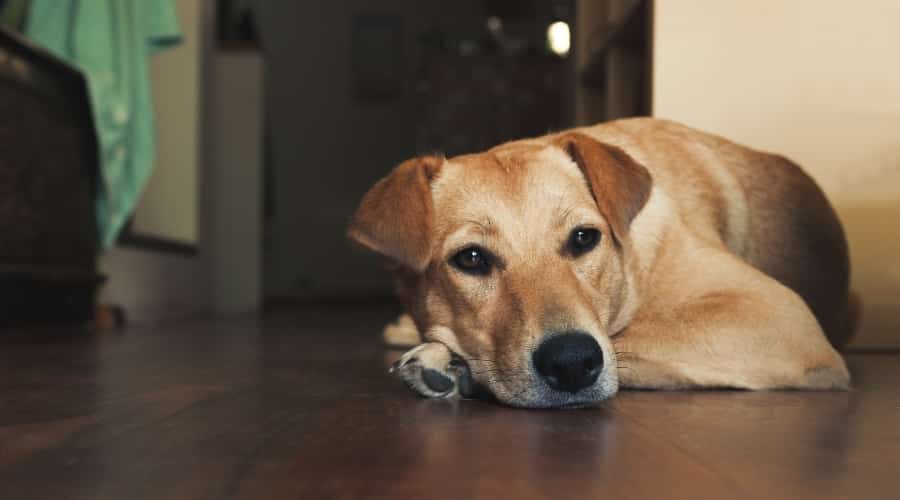
Dogs with chronic sleep apnea may also experience reduced quality of life, as interrupted sleep leads to irritability, anxiety, and reduced exercise tolerance.
Red Flag: If your dog ever stops breathing for more than 20 seconds, appears disoriented upon waking, or collapses, treat it as an emergency.
When It’s Time To Call The Vet
If you notice any of the following, schedule a veterinary visit right away.
- Persistent, loud snoring or gasping sounds during sleep
- Your dog appears tired even after a full night’s rest
- Pauses in breathing that happen multiple times per night
- Snoring worsens after weight gain or allergy flare-ups
- Behavior or energy levels change suddenly
How To Monitor Your Dog’s Breathing At Home
Between vet visits, you can do a lot to track how well your dog sleeps. A few minutes of quiet observation each night can reveal patterns your vet will want to see.
Easy At-Home Observation Tips
- Record short clips of nighttime breathing
- Watch for sleep position changes (upright, chin lifted, etc.)
- Note any daytime fatigue or mouth breathing
- Keep a symptom log for vet review
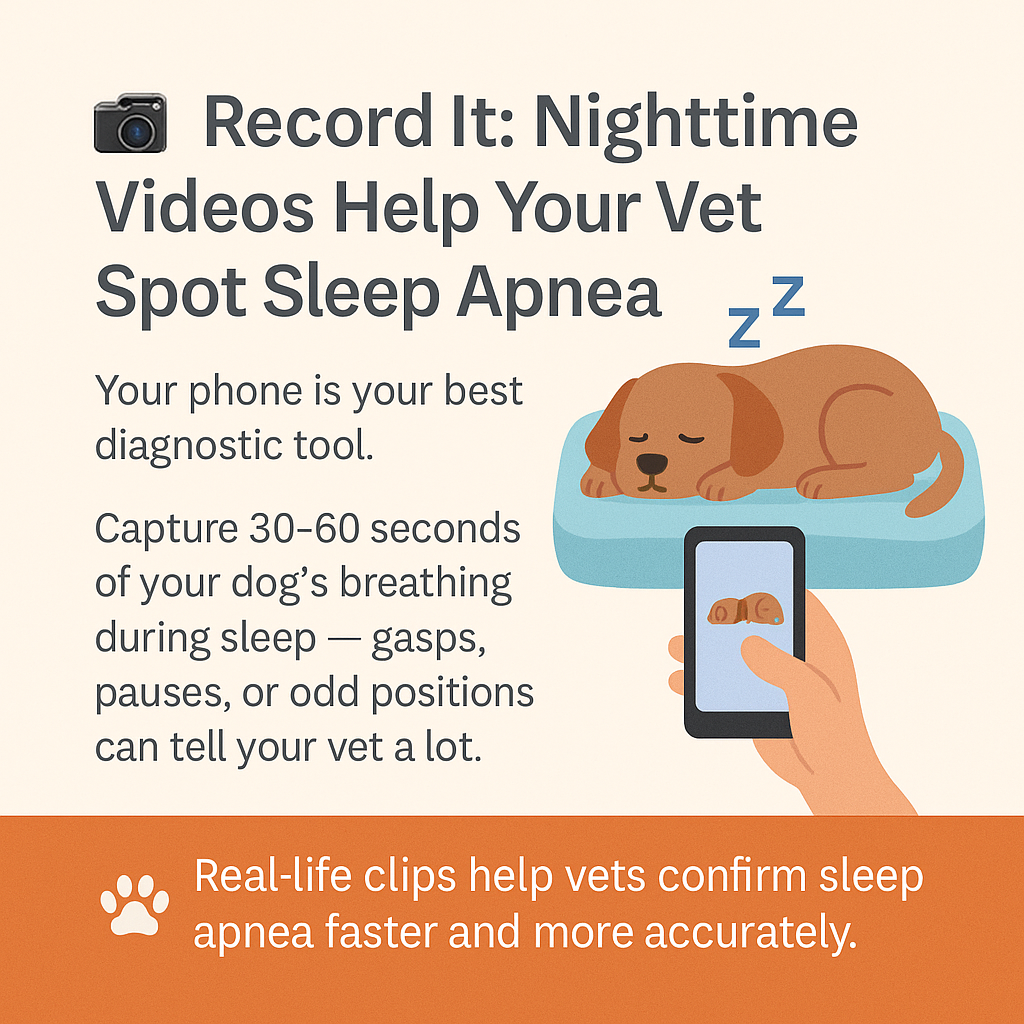
How Vets Diagnose & Treat Sleep Apnea In Dogs
The right treatment depends on what’s causing the airway obstruction. Since sleep apnea is usually a symptom rather than a standalone condition, your vet’s first goal is to identify and correct the underlying issue, whether that’s anatomy, allergies, weight, or another medical problem.
How Vets Figure Out What’s Going On
Because traditional sleep studies (like human polysomnography) are rarely performed on pets, vets rely on a combination of observation, imaging, and symptom history.
Your vet may:
- Review a home video of your dog’s breathing patterns at night
- Perform a physical exam of the nose, mouth, and throat
- Recommend chest or neck X-rays or CT imaging to check for airway narrowing or collapse
- Use blood oxygen level testing to measure how well your dog breathes while sleeping
If your dog is brachycephalic (short-nosed), your vet might also perform a BOAS evaluation to check for surgically correctable issues like an elongated soft palate or stenotic nares.

If an underlying condition is found, treatment is focused on improving airflow and reducing inflammation.
Medications, Weight Loss & Other Fixes
- Anti-inflammatory medications may help reduce swelling in the throat or nasal passages.
- Allergy treatments, including antihistamines, corticosteroids, or environmental changes, can reduce congestion that worsens sleep apnea.
- Weight management plans can dramatically reduce symptoms in overweight dogs.
Some vets may prescribe ondansetron (Zofran), a serotonin antagonist typically used for nausea, because research shows it can improve airway stability in some cases of obstructive sleep apnea. However, this is considered an off-label use and should only be done under close veterinary supervision.
Vet Insight: Always discuss potential medication side effects and dosage specifics with your veterinarian. What works for one breed or body type may not suit another.
Surgical Options
For dogs with Brachycephalic Obstructive Airway Syndrome (BOAS) or other structural airway abnormalities, surgery may be recommended to physically widen the airway and restore smooth airflow during sleep. These procedures are performed by board-certified veterinary surgeons, often using specialized soft-tissue techniques.
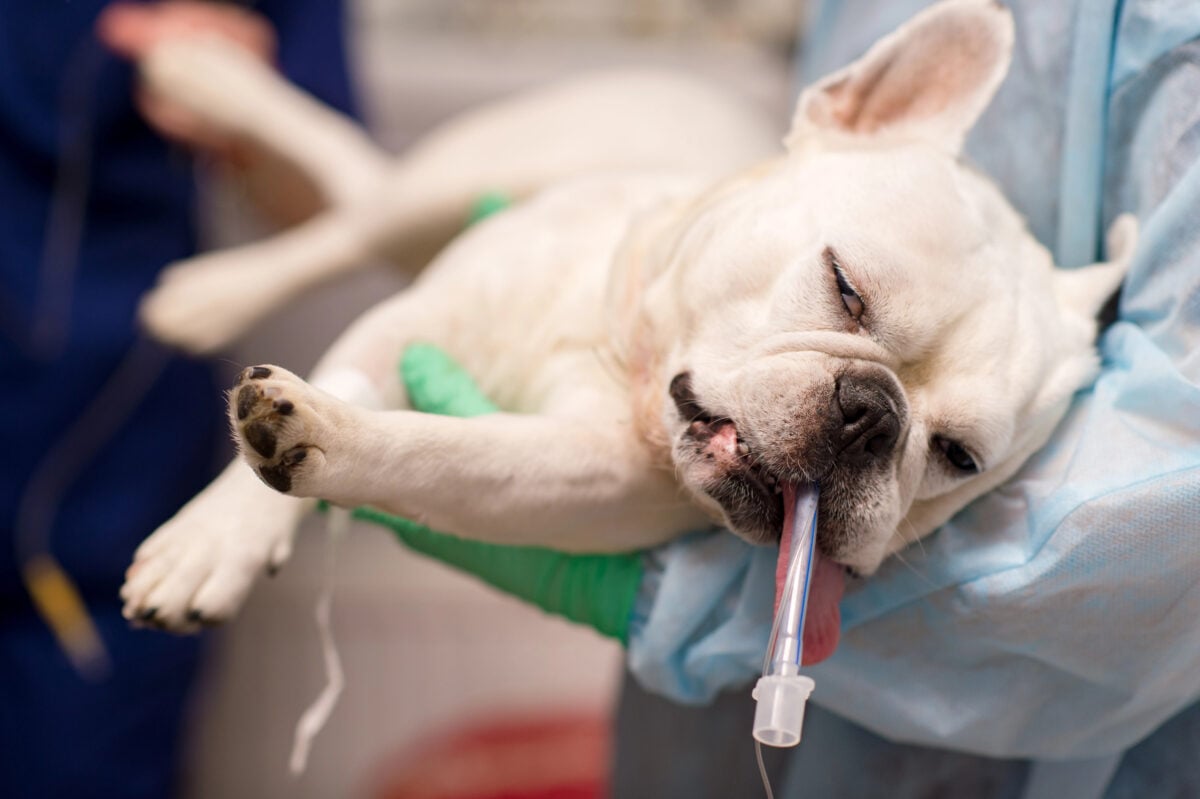
1. Soft Palate Resection (Shortening the Soft Palate)
In many flat-faced dogs, the soft palate extends too far back, partially blocking the entrance to the windpipe. During surgery, the excess tissue is trimmed and reshaped to create more space for air to pass freely.
- Goal: Prevent airway obstruction when throat muscles relax during sleep.
- Recovery: Most dogs go home the same day, with restricted activity and a soft-food diet for about two weeks.
- Outcome: Noticeably quieter breathing and less nighttime snoring once swelling subsides.
2. Stenotic Nares Repair (Widening Narrow Nostrils)
Some dogs are born with very narrow nostrils (nares) that make every breath a struggle, especially during exertion or rest. Surgeons can remove small wedges of tissue from the nostrils to enlarge the openings and improve airflow.
- Goal: Allow more air through the nose to reduce mouth breathing and strain on the airway.
- Recovery: Mild swelling and temporary sneezing are common; healing usually occurs within 10–14 days.
- Outcome: Many owners notice immediate improvement in breathing and energy levels.
3. Laryngeal Saccule Removal (Everted Sacculectomy)
Chronic airway strain can cause tiny tissue pouches, called laryngeal saccules, to flip inside out and block airflow. A surgeon can carefully remove the protruding tissue to restore a clear pathway to the lungs.
- Goal: Eliminate soft-tissue obstruction near the vocal cords that worsens with snoring or exertion.
- Recovery: Similar to palate surgery; dogs are monitored for airway swelling and given anti-inflammatory medication.
- Outcome: Smoother, quieter breathing and improved oxygen levels during sleep.
Vet Insight: Some brachycephalic dogs benefit from a combination of these surgeries, performed in a single session. When addressed early, they can dramatically improve quality of life and even extend lifespan.
Why Pet Insurance Is Worth Considering
Whether it’s breathing problems, allergies, or even an unexpected injury or other illness, vet bills can add up quickly. Pet insurance helps cover the cost of diagnostics and treatment for many accidents and new illnesses.
To compare coverage for common issues like respiratory conditions, obesity-related illness, and emergencies, check out our expert guide to the best pet insurance providers.
Tip: Most plans don’t cover pre-existing conditions, so it’s best to enroll your pup before any breathing problems or other symptoms appear.
How To Help Prevent Sleep Apnea Before It Starts
While some causes of sleep apnea (like genetics or anatomy) can’t be avoided, you can take several steps to reduce your dog’s risk and promote easier nighttime breathing.
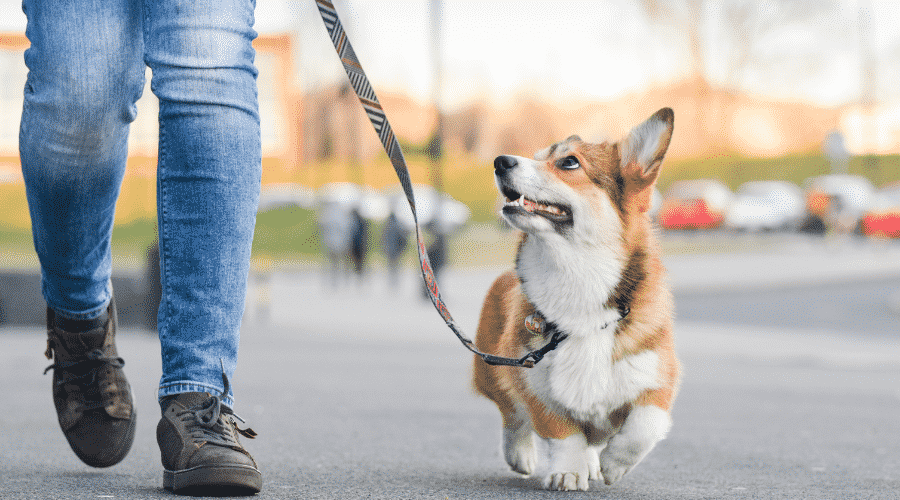
1. Keep Your Dog at a Healthy Weight
Extra pounds put pressure on the chest and throat, which can worsen airway collapse. Feed a nutritious, portion-controlled diet and make daily walks a routine. Even modest weight loss can help reduce snoring and improve oxygen flow.
3. Manage Allergies Early
If your dog’s breathing worsens during pollen season or around dust, talk to your vet about allergy testing or medication. A dehumidifier or air purifier can also minimize triggers indoors.
4. Create a Sleep-Friendly Environment
Keep your dog’s sleep area quiet, cool, and clean. Wash bedding weekly to remove allergens and use a slightly elevated bed for dogs who snore heavily, especially brachycephalic breeds.
Pro Tip: Orthopedic dog beds can help improve airflow by taking pressure off the neck and chest.
5. Schedule Regular Vet Visits
Routine checkups help catch respiratory or cardiac changes before they worsen into chronic sleep apnea. Ask your vet to evaluate breathing sounds, nasal airflow, and weight each visit, especially as your dog ages.
Other Sleep Problems That Can Look Like Sleep Apnea
Sleep apnea isn’t the only sleep-related issue your dog might face. While uncommon, other canine sleep disorders can mimic or compound breathing problems.
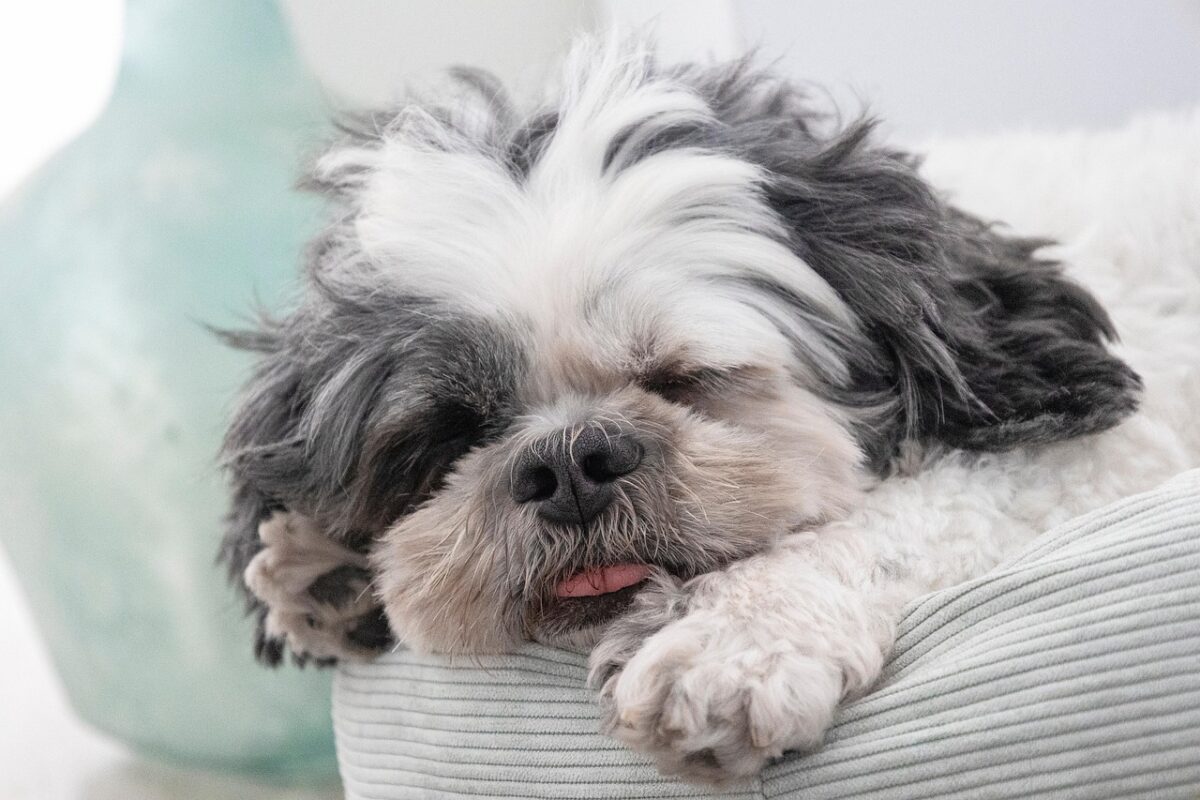
Insomnia
Dogs may struggle to fall or stay asleep due to pain, anxiety, or environmental changes (like moving homes or new pets). Insomnia is often secondary to another medical or behavioral issue.
Narcolepsy
A rare neurological disorder that causes dogs to suddenly fall asleep during activity, sometimes collapsing mid-play. It’s most often genetic and diagnosed through specialized testing.
REM Sleep Behavior Disorder
In this condition, dogs act out their dreams by barking, running, or snapping in their sleep. It’s harmless in mild cases but can occasionally lead to self-injury or household accidents.
Fun Fact: Dogs spend about 10–12% of their sleep in the REM stage, which is when they dream. Twitching paws or soft “woofs” are totally normal!
Frequently Asked Questions
Dog snoring and sleep issues can be confusing, especially when symptoms come and go. Below are some of the most common questions pet parents ask about canine sleep apnea and nighttime breathing problems. Don’t see yours here? Ask us in the comments!
Does A Dog Snoring Indicate Sleep Apnea?
Not always, but it can be a clue.
Occasional snoring is normal, especially if your pup’s had a long, active day or is sleeping in a funny position. However, consistent, loud snoring accompanied by gasping, choking, or breathing pauses could point to sleep apnea or another airway issue.
If your dog’s snoring is new, worsening, or paired with fatigue, it’s best to record a short clip and share it with your vet for review.
Can Dogs Die From Sleep Apnea?
Severe, untreated sleep apnea can become life-threatening over time. Repeated oxygen deprivation strains the heart, lungs, and brain, increasing the risk of long-term complications like high blood pressure and cardiac issues.
While sudden death from sleep apnea alone is rare, chronic oxygen loss and fatigue can shorten your dog’s lifespan and significantly reduce their quality of life. Early diagnosis and management make a big difference.
How Do Vets Test For Sleep Apnea In Dogs?
Most veterinarians start by ruling out other causes of noisy or labored breathing, like allergies, infections, or nasal blockages.
Tests may include:
- Airway and nasal exams under mild sedation
- X-rays or CT scans of the neck and chest
- Blood oxygen level monitoring
Specialized veterinary hospitals can perform sleep studies (polysomnography) similar to human labs, but these are rare and usually reserved for complex cases or research.
What Breeds Are Most At Risk?
Dogs with short, flat faces, known as brachycephalic breeds, are the most vulnerable due to their naturally narrow airways. These include:
- Bulldogs (English, French)
- Pugs
- Boston Terriers
- Boxers
- Shih Tzus
- And more
Overweight dogs and seniors also face a higher risk, even if they aren’t brachycephalic.
Can Dogs Outgrow Sleep Apnea?
In most cases, no, but symptoms can improve with treatment. Puppies with mild airway inflammation or obesity-related apnea may see relief once the underlying cause is addressed. However, structural issues (like BOAS) typically require surgical correction to fully resolve.
Long-term management focuses on healthy weight, allergy control, and avoiding overheating, all of which can help minimize flare-ups.
Are There CPAP Machines for Dogs?
While CPAP (continuous positive airway pressure) therapy revolutionized human sleep apnea treatment, there’s no canine-specific CPAP machine currently on the market.
Human CPAP machines are not an appropriate treatment option for dogs because they have different anatomical and physiological characteristics that make it difficult to fit and use CPAP masks effectively.
Understanding Your Dog’s Sleep Habits
Sleep is when your dog’s body repairs, dreams, and recharges — so any disruption can take a toll on their health and mood. Understanding canine sleep patterns helps you spot what’s normal and what’s not.
Curious about your dog’s nighttime habits? Explore these related reads:
Have you ever noticed your dog stop breathing or gasp during sleep? Share your experience in the comments — your story could help another pet parent spot the signs early.
